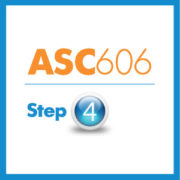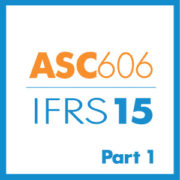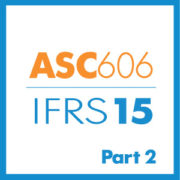ASC 606 Step-by-Step Step 4: Allocate Transaction Price
With just over a year to go for private companies to have their ASC 606 plans in place, many organizations are yet to have done much to get the ball rolling. This is why we began this series, to introduce you to the various steps involved in recognizing revenue under the new standard.
Background
As part of an ongoing series, we are breaking down the 156-page standard and providing key takeaways, including who ASC 606 affects, a brief overview on the five steps, and a look at how ASC 606 will affect different industries, but today we would like to introduce a deeper look at each step:
- Identify Contract(s) with a Customer
- Identify Performance Obligations in the Contract
- Determine the Transaction Price
- Allocate the Transaction Price to the Performance Obligations in a Contract (August)
- Recognize the Revenue When (or as) the Entity Satisfies a Performance Obligation (September)
ASC 606 Deep Dive Step 4: Allocating Transaction Price to the Performance Obligations
Biggest Impacts: Software, Telecommunications
With considerations including standalone selling price, allocating discounts and variable consideration, and changes in the transaction price, there are certain pitfalls in allocating price to each obligation.
Determine/Estimate Standalone Selling Prices
After Step 3, determining the transaction price as a whole, you will need to determine the standalone selling price of each good and/or service promised in step 4. As is often the case, the way to do this is to determine the price based on standalone sales of the good or service to similarly situated customers.
However, this is not often observable. When this is the case, a seller is to determine standalone prices in one of three ways:
- Adjusted Market Assessment Approach: Evaluate the market in which goods or services are sold and estimate the price that customers are willing to pay.
- Expected Cost Plus Margin Approach: Forecast the expected costs of satisfying a performance obligation and add an appropriate margin for that good or service.
- Residual Approach (rare): Subtract the sum of observable stand-alone selling prices of other goods or services promised from the transaction price. This is only usable if the following two criteria are met:
- The entity sells the same good or service to different customers (at or near the same time) for a broad range of amounts (that is, the selling price is highly variable because a representative standalone selling price is not discernible from past transactions or other observable evidence).
- The entity has not yet established a price for that good or service, and the good or service has not previously been sold on a standalone basis (that is, the selling price is uncertain).
Oddly, for US-based businesses, the new standard will provide more flexibility for organizations than the previous standard, a rare occurrence within ASC 606 according to the KPMG Revenue Issues in Depth Article. Under the current standard, standalone selling prices are often established by determining vendor-specific objective evidence (VSOE).
Developing a Standalone Price Determining Framework
Notably, determining standalone prices will require a fair amount of judgement from the selling entity, as many organizations do not have robust processes in place for determining prices. To reasonably establish controls, KPMG recommends organizations follow this five-step process.
- Gather all reasonably available data points (cost to manufacture, profit margins, third-party pricing, etc.)
- Consider adjustments based on market conditions (demand, competition, awareness) and entity-specific factors (market share, pricing, bundled pricing)
- Consider organizing selling prices into meaningful groups.
- Weigh available information and make the best estimate.
- Establish ongoing processes for monitoring and evaluating prices.
Allocating a Discount
A discount should be allocated entirely to one or more, but not all, performance obligations in the contract if all of the following criteria are met:
- The entity regularly sells each distinct good or service (or each bundle of distinct goods or services) in the contract on a standalone basis.
- The entity also regularly sells on a standalone basis a bundle (or bundles) of some of those distinct goods or services at a discount to the standalone selling prices of the goods or services in each bundle.
- The discount attributable to each bundle of goods or services described in (b) is substantially the same as the discount in the contract, and an analysis of the goods or services in each bundle provides observable evidence of the performance obligation (or performance obligations) to which the entire discount in the contract belongs.
If a discount is allocated entirely to one or more performance obligations in the contract, an entity should allocate the discount before using the residual approach to estimate the standalone selling price of a good or service.
KPMG brings up a few observations, most notably that entities should take a different approach when a large amount of goods and services are bundled in various ways, and to establish a policy for determining what ‘regularly sells’ together.
Allocating Variable Consideration
Variable consideration that is promised in a contract may be attributable to the entire contract or to a specific part of the contract, such as either of the following:
- One or more, but not all, performance obligations in the contract (for example, a bonus may be contingent on an entity transferring a promised good or service within a specified period of time)
- One or more, but not all, distinct goods or services promised in a series of distinct goods or services that forms part of a single performance obligation (in accordance with FASB ASC 606-10-25-14(b)) (for example, the consideration promised for the second year of a two-year cleaning service contract will increase on the basis of movements in a specified inflation index)
While discussed after the application of discounts in the standard, variable consideration allocation needs to be completed before allocating a discount. For more information, see our discussion on the differences between variable consideration and discounting in our analysis of step 2.
Changes in Transaction Price
Prices change, and for that, there are certain paths to follow and pitfalls to watch. If and when this does happen, an entity should allocate to the performance obligations in the contract any subsequent changes in the transaction price on the same basis as at contract inception.
Consequently, the transaction price should not be reallocated to reflect changes in standalone selling prices after contract inception. Amounts allocated to a satisfied performance obligation should be recognized as revenue, or as a reduction of revenue, in the period in which the transaction price changes.
Allocating Price Changes to Performance Obligations
A change in the transaction price should be allocated entirely to one or more, but not all, performance obligations or distinct goods or services promised in a series that forms part of a single performance obligation, but only if both of the following criteria are met:
- The terms of the change in transaction price relate specifically to the entity’s efforts to satisfy the performance obligation or transfer the distinct good or service (or to a specific outcome from satisfying the performance obligation or transferring the distinct good or service).
- Allocating the change in transaction price entirely to the performance obligation or the distinct good or service is consistent with the overall objective for allocating the transaction price to performance obligations, when considering all of the performance obligations and payment terms in the contract.
A change in the transaction price that arises as a result of a contract modification should be accounted for in accordance with the guidance on contract modifications. However, for a change in the transaction price that occurs after a contract modification, an entity should apply the guidance in whichever of the following ways is applicable:
- Allocate the change in the transaction price to the performance obligations identified in the contract before the modification if, and to the extent that, the change in the transaction price is attributable to an amount of variable consideration promised before the modification and the modification is accounted for as if it were a termination of the existing contract and the creation of a new contract (in accordance with FASB ASC 606-10-25-13(a)).
- In all other cases in which the modification was not accounted for as a separate contract (in accordance with FASB ASC 606-10-25-12), allocate the change in the transaction price to the performance obligations in the modified contract (that is, the performance obligations that were unsatisfied or partially unsatisfied immediately after the modification).
Conclusion: Time to Get Moving
16 months may seem like a long time (it’s only five if you’re a public entity), but many organizations are seeing challenges in making the move to implement new processes and systems to meet the requirements of the new standard.
Even if we’re posting monthly blogs leading up to the effective date, you should already be looking at transition methods and other industry-specific considerations that you need to make. To address this, we’ve compiled a list of resources for companies looking to prepare for the upcoming standard:
- Analyst Report: Intacct Leads the Way in ASC 606 and IFRS 15 Revenue Recognition
- Six Rules for ASC 606 Readiness
- ASC 606 and Subscription Businesses—Why Compliance Can’t Wait
On Demand Webcasts: ASC 606/IFRS 15
Sage Intacct recently presented a three-part series on the new standards, which you can view on-demand.
- Part 1: New FASB Rev Rec Standards, Actions You Should Take Now!
- Part 2: The Impending Impacts of ASC 606 on Subscription Businesses
- Part 3: Master Your Transition to ASC 606 and IFRS 15
We welcome you to peer through the full text, the AICPA guidance, and to get in contact with us to learn more about preparing for ASC 606 with outsourced accounting services and/or a new accounting software designed with new RevRec Standards in mind.











Leave a Reply
Want to join the discussion?Feel free to contribute!